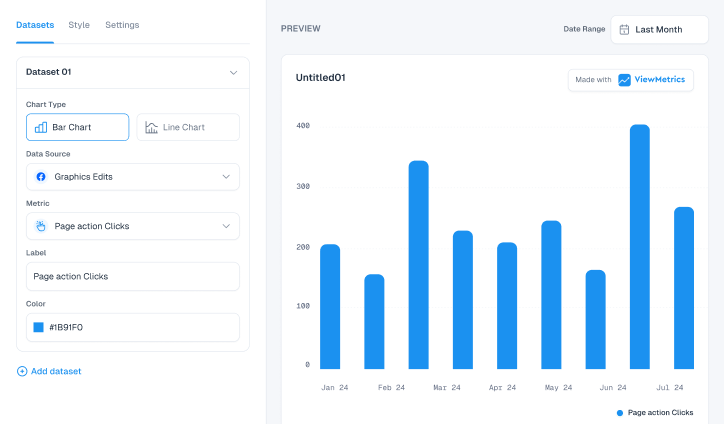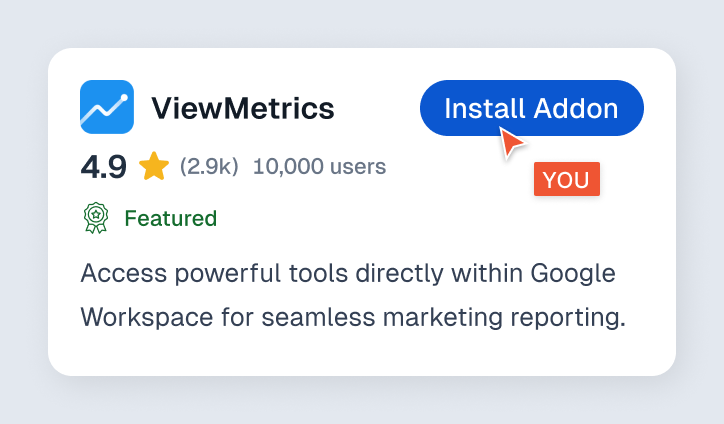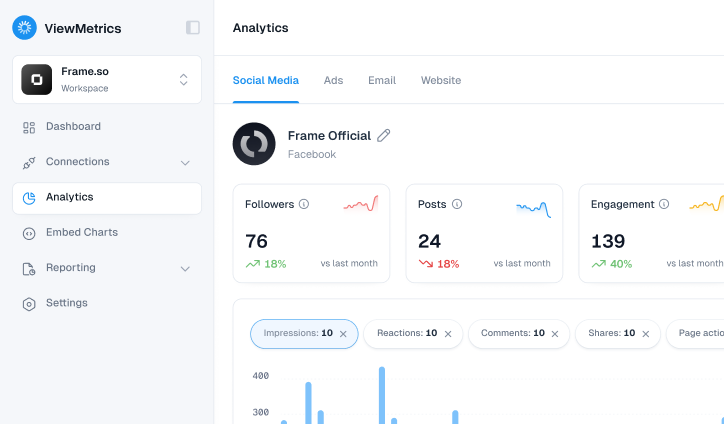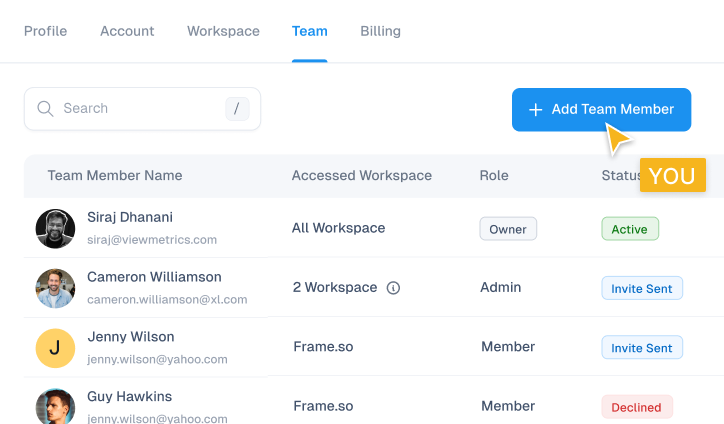Summary for the Blog
- Reach is the number of unique individuals who have seen your content. It measures how many people your message has potentially reached.
- Impressions are the total number of times your content has been displayed to users, regardless of whether they are unique. A single user can generate multiple impressions.
- A key distinction is that one person seeing your post three times would count as one reach but three impressions.
- Both metrics are important for different reasons: Reach is crucial for measuring brand awareness and audience expansion, while Impressions are useful for assessing content visibility and popularity.
Social media engagement is crucial for both online and offline businesses. To measure its success, many metrics are used, with reach and impressions being two of the most important. While these terms are often used together, they are not the same.
Understanding the difference between reach and impressions is essential for a successful social media strategy. Both metrics impact your overall engagement and visibility, but each has its own specific meaning.
In this blog, we’ll delve deeper into the difference between reach and impressions, looking at how they work, and why they’re important for your business. Let’s get started.
What is Reach?
Reach is a metric that measures the total number of unique individuals who have seen your content. It’s a way to measure the potential audience your message has reached. When a user encounters your content, whether it’s a social media post, an ad, or a blog article, they’re considered to have been “reached.”
Imagine you’re throwing a party. Reach would be the number of people who hear about the party and show up. The more people who hear about it, the larger your potential audience.
Another example would be thinking of it like throwing a net into a pond. The net represents your content, and the fish are the potential audience. The wider you cast your net (the more people you reach), the more fish (potential customers) you’ll catch. Reach is a crucial factor in expanding your audience, increasing brand awareness, and ultimately driving engagement and conversions.
What are Impressions?
Impressions are the total number of times your content has been displayed to users, regardless of whether those users are unique or have seen it before. It’s like counting how many times your ad or post has appeared on someone’s screen.
Think of it this way:
If someone scrolls past your post twice, that’s two impressions. Even if they’ve seen it before, each time it appears in their feed, it counts as an impression.
Impressions are a good way to measure content visibility. They can help you understand how often your message has been seen by potential customers.
For example, check our guide on What are impressions on LinkedIn to know more about LinkedIn-specific impressions.
The Main Differences Between Reach and Impressions

Reach and impressions are two important metrics in social media, but they measure different things. Reach is the total number of unique people who see your content. Impressions, on the other hand, are the total number of times your content is displayed, regardless of whether it’s clicked on or not.
To put it simply, reach is about how many different people see your post. Ideally, every one of your followers would see everything you post, but in reality, not all of them will. Reach counts each person only once, no matter how many times they see your content.
Impressions, however, count the total number of times your content appears in someone’s feed. If one person sees your post three times, that counts as three impressions, but it still only counts as one for reach because it’s the same person.
For example, if you see a Facebook post once in the original publisher’s feed and then again when a friend shares it, that would count as two impressions for the same post. But the reach remains one, as you are a single person.
Let’s go through a simple scenario: You have 200 followers and you decide to make a new post. If all 200 followers see it, you will have a reach of 200 and 200 impressions. If you publish two posts the next day, and all your followers see both, your reach remains 200, but now you have 400 impressions.
Sometimes, the number of impressions can be higher than your follower count or reach. This happens when people who aren’t your followers see the content, such as when it’s shared by others. For instance, if six people share your post and each of their followers sees it, those views count towards your impressions but not your reach.
Understanding the difference between reach and impressions is important for evaluating the success of a social media campaign, especially when you’re also tracking other engagement metrics.
Reach vs Impressions on Various Platforms
1. Facebook
Facebook provides a detailed analysis when it comes to understanding reach and impressions. These metrics are broken down into three categories:
- Organic: This refers to how often your content appears in users’ feeds naturally (impressions) and the number of unique users who see it (reach) without any paid promotion.
- Paid: This tracks the reach and impressions generated through paid advertising on Facebook, showing how your sponsored content performs.
- Viral: This indicates the reach of your content due to sharing by others and how many times it has appeared in someone’s feed because of those shares (impressions).
For Facebook Ads specifically, the platform also provides data on two types of impressions:
- Served Impressions: This is when an ad is delivered to someone’s feed, though they might not scroll down far enough to see it or might exit before the ad fully loads.
- Viewed Impressions: This counts when an ad actually appears in someone’s feed, even if the user doesn’t engage with it.
Tip: You must try ViewMetrics’ Facebook performance report template to track your reach and impressions.
Also Read: Facebook KPIs: A Guide to Track Your Success
2. Instagram
On Instagram, “reach” and “impressions” are two important numbers that tell you how well your posts and stories are doing. If you have a business or creator account, you can see these numbers by clicking “View Insights” under a post or swiping up on a story. Business accounts show you some basic info, but creator accounts have more details.
When you check a post’s analytics, you can see not only reach and impressions but also what percentage of the people who saw it weren’t following you. You can also see where those impressions came from, like hashtags, your profile, the explore page, and other places.
For a bigger picture, go to the Activity tab in Insights. There, you’ll find your weekly reach and impressions under the Discovery section.
For stories, the analytics aren’t as detailed. You can’t see where people saw your story or what percentage weren’t following you. But you can see if people went back, forward, to the next story, or left Instagram after watching your story.
These numbers can help explain why your impressions might be higher than your reach. For example, if someone watches your story twice or visits your profile a few times, it’ll count as one reach but more impressions.
Tip: Use ViewMetrics’ Instagram Dashboard to track your Instagram page’s reach and impressions.
Also Read: Track Instagram KPIs for Success
3. X (Twitter)
When you check the analytics for a tweet, you’ll see data on impressions and engagements, but not reach. Twitter doesn’t track reach directly, only the number of times your tweet has been seen (impressions). To find out how many unique users have seen your tweets, you’ll need a third-party tool.
Impressions show how often your tweet appears on people’s feeds, in search results, or through other people’s engagement. But they don’t include views from third-party platforms, text previews, or embedded tweets.
Impressions can tell you a lot about your brand’s presence on Twitter. But to understand how relevant your content is, you should also look at engagement.
Tip: You can use ViewMetrics’ Social Media Performance Overview Template to track your Twitter or X profile reach and impressions.
Also Read: Twitter Metrics: 13 KPIs You Need to Track for Better Results
4. LinkedIn
On platforms like Facebook, Twitter, and Instagram, you can easily track your overall impressions and, in some cases, reach over time. However, LinkedIn handles things a bit differently. Instead of providing a “reach” metric, LinkedIn gives you the number of unique impressions for each post.
This essentially tells you the same thing—how many people saw your content. For a view to count as an impression on LinkedIn, at least 50% of your post must be visible on the screen for at least 300 milliseconds.
Tip: Use ViewMetrics’ LinkedIn Dashboard to track your LinkedIn reach and impressions.
Also Read: LinkedIn KPIs: Key Metrics for Engagement & Lead Generation
5. YouTube
YouTube analytics provide a detailed look into four key metrics related to reach:
- Unique Viewers (Reach): This metric tells you the number of unique people who have watched your videos. It’s essentially the same as ‘reach,’ showing how many individual viewers your content has attracted.
- Impressions: Impressions count how many times your video thumbnails were displayed to viewers on YouTube, indicating potential opportunities for your content to be noticed.
- Traffic Sources for Impressions: This metric shows where on YouTube your video thumbnails were displayed, helping you understand the different places your content might be discovered.
- Impressions Click-Through Rate (CTR): This metric reflects the conversion rate, showing how often viewers clicked to watch your video after seeing the thumbnail.
Tip: You can use ViewMetrics’ YouTube performance report template to track your YouTube Channel’s reach and impressions.
6. Snapchat
Snapchat uses similar concepts for reach and impressions. However, it refers to impressions as story views, which track how many times your stories were viewed.
7. Google Analytics
Google Analytics provides insights into how users interact with your website, focusing on metrics like users and page views.
The ‘users’ metric is similar to reach—it tells you how many unique individuals have visited your site during a specific period.
On the other hand, ‘page views’ reflects the total number of times pages on your site have been viewed by all visitors. With the introduction of Google Analytics 4 (GA4), you can now gather all these metrics in one place, using integrations to build comprehensive live performance dashboards.
Tip: Use ViewMetrics’ Free Monthly Marketing Report Template to track your reach and impressions.
8. Google Ads
Google Ads tracks reach using two different methods: unique reach and cookie-based reach. It’s important to know the difference between these methods to understand your data correctly and follow cookie rules.
- Unique Reach: This measures the total number of people who have seen your ad on different devices, formats, and networks. It includes the number of unique users and how many times the ad was shown to each user.
- Cookie-Based Reach: This method counts the number of cookies that served an ad or recorded a click. Because people often use multiple devices or browsers, cookie-based reach is an estimate and might include some duplicate views.
Track Your Social Media Impact with ViewMetrics – Analyze reach and impressions in one dashboard.
View All Your Marketing and Website Data - Instantly
Connect Instagram, Mailchimp, Google Analytics & more
Pre-built dashboards, no setup needed
Save hours on reporting every week

Tips to Improve Your Reach and Impressions
1. Understand Your Audience
To make your content more engaging, it’s crucial to understand who your audience is. Find out what types of content they enjoy most—whether it’s articles, photos, or videos.
Testing different content formats can help you see what resonates best with them. By tailoring your content to their preferences, you can boost engagement and interaction.
2. Create Shareable Content
To make your content more likely to be shared, it should be both interesting and engaging. Knowing your audience helps you create material that appeals to them.
Incorporate trending topics and popular phrases to make your content relatable and appealing. This can encourage your audience to share it with others.
3. Post When Your Audience Is Active
Timing is super important when it comes to posting content. Try to post when your followers are most active to increase visibility. Research the best times to post based on your audience’s habits and feedback.
Consider factors like location, time zones, and days of the week to find the best times for posting online. This can help you maximize interaction and reach.
4. Invest in Paid Promotions
Using paid promotions can boost your content’s visibility by influencing how algorithms work on social media platforms. Platforms like Facebook, Twitter, Instagram, and LinkedIn offer various advertising packages at different prices, so you can choose one that fits your budget. It’s a good idea to try out different packages to see which one works best for you.
5. Consider Search Keywords
Optimizing your search keywords can improve your ranking in search results. This helps your content reach people who are interested in it. Conducting market research can help you find the most effective keywords to use for better results.
6. Use Relevant Hashtags for the Content You Post Online
Hashtags are useful for finding and categorizing content on social media. By using relevant hashtags related to your content, you can increase the chances of your posts appearing in search results. Trending hashtags can also help give your content more exposure.
7. Monitor Platform-Specific Changes
Keeping an eye on changes specific to each social media platform can help you stay up-to-date with how your content is being received. Social media platforms often update their algorithms and features, which can affect how your posts are seen by others.
By staying informed about these changes, you can adjust your strategy to maintain or improve your content’s visibility and engagement.
8. Analyze Data from Multiple Platforms
Looking at data from various social media platforms can give you a clearer picture of how well your content is performing across the board. By comparing metrics like engagement rates, reach, and audience demographics from different platforms, you can understand what works best and make informed decisions to enhance your overall strategy.
This approach helps you see patterns and trends that can guide your content creation and advertising efforts.
Reach Vs Impressions: What is More Important?
Now that you know the difference, you might be asking: which metric is more important? The answer is both!
Reach is the total number of unique people who have seen your content. It’s crucial if you’re trying to expand your audience and increase brand awareness. A high reach means your content is reaching more people and has the potential to attract new followers or customers.
Impressions, on the other hand, represent the total number of times your content has been seen, including multiple views by the same person. While impressions can be useful for measuring content popularity and engagement, it’s important to note that a high number of impressions doesn’t necessarily indicate genuine interest. Multiple views from the same individual might simply be due to repeated scrolling or browsing.
In the end, combining both metrics, along with other engagement indicators like likes, shares, and comments, gives a better understanding of how your content is doing. By knowing the strengths and weaknesses of each metric, you can make informed choices about your content strategy and measure its success more accurately.
Also Read: What is the Difference Between Impressions and Clicks?
How to Track Reach and Impressions?
Most social media platforms come with built-in tools that let you track how many people see your posts and how many times they’re viewed. But if you need a more detailed and organized view, using a dedicated analytics platform can be really helpful.
Most social media platforms come with built-in tools that let you track how many people see your posts and how many times they’re viewed. But if you need a more detailed and organized view, using a dedicated analytics platform can be really helpful.
ViewMetrics: A Useful Tool for Tracking Reach and Impressions
ViewMetrics is a handy analytics platform that helps you keep track of reach and impressions across different platforms. It gives you a central dashboard where you can see data from various sources all in one place, which is great for bigger teams. Some of the main features of ViewMetrics include:
- Cross-Platform Tracking: You can monitor reach and impressions from different places like social media, email, and your website.
- Industry Benchmarking: Compare your results with industry standards to see how you’re doing and where you can improve.
- Detailed Analytics: Get insights into who your audience is, how engaged they are, and other important metrics.
- Customization: Adjust your dashboard to focus on the data that’s most important for your business.
With ViewMetrics, you can better understand how your content is performing and use that information to improve your marketing efforts.
View All Your Marketing and Website Data - Instantly
Connect Instagram, Mailchimp, Google Analytics & more
Pre-built dashboards, no setup needed
Save hours on reporting every week

Closing Thoughts
We hope this blog helped clear up the difference between reach and impressions. Understanding these metrics can help you improve your social media strategy and better measure your content’s impact. Use this knowledge to enhance your engagement and visibility.
Frequently Asked Questions
How can I keep track of how many people see my digital marketing campaigns?
Use tools like Google Analytics, Facebook Insights, and ViewMetrics to get detailed information on reach and impressions. This will help you understand how well your campaigns are doing and make necessary changes.
Does it matter which social media platform I’m on when it comes to reach and impressions?
Yes, different platforms have different ways of showing content to people. This means that reach and impressions might work differently on each one. It’s important to adjust your strategies to fit each platform.
Which is better for getting my brand known: reach or impressions?
Reach is usually more important for brand awareness because it tells you how many different people saw your content. Impressions can also be helpful, but they might include people seeing your content multiple times.











